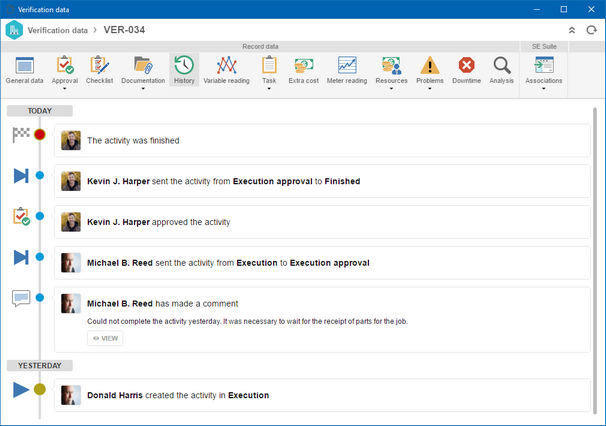
Asset timeline
In order to allow a greater control over the events related to the asset, a timeline was made available in its history, in which it is possible to analyze the events related to the asset over time. By means of hyperlinks in the timeline, it is possible to quickly access the details of each event, making it unnecessary to perform other types of searches in order to view the desired information.
Maintenance route associated with the asset data
The configuration of the asset controls has been modified to also relate the Maintenance Route plans in which the asset is related, thus making it easier to configure them and view the plans the asset is part of. From this screen, it is possible to view the plan data, as well as, if needed, to create a new Maintenance Route plan.
General parameter for retroactive dates in execution
To allow a greater control over deadline indicators for the execution of verification activities, a general parameter has been made available. It blocks the execution of activities with retroactive dates. The parameter allows the user to enter only the current date, thus blocking the execution of past dates.
Third quadrant for verification activities
Aiming to obtain quick access to the information of verification activities, the third quadrant has been made available on the verification view screen. Among the available options, it will be possible to view, without having to open the activity data, information such as: history, attributes, documentation, variable and meter readings, tasks, costs, resources, and problem analyses.
Verification activity timeline
To allow a greater control over the verification activity progress, a timeline has been made available in the activity history, where it is possible to quickly view the steps through which the activity has already gone through, as well as the parties that were responsible for those steps.
New frequency unit for verification plans
Seeking to broaden the frequency control possibilities, the option to define the configuration by “Working days” as the plan frequency has been made available. That way the system can now control the time frequency considering only the working days, according to the related calendar.
Explanation when canceling a verification activity
In order to allow a greater control over canceled activities, when selecting the option to cancel, the system now requires to enter an explanation for the cancelation. That information is then available in the activity history, containing the explanation as well as the user responsible for the cancelation.




